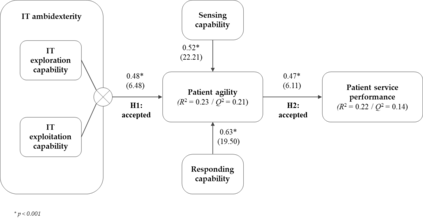Hospitals are currently exploring digital options to transform their clinical procedures and their overall engagement with patients. This paper investigates how hospital departments can leverage the ability of firms to simultaneously explore new IT resources and practices (IT exploration) as well as exploit their current IT resources and practices (IT exploitation), i.e., IT ambidexterity, to adequately sense and respond to patients' needs and demands, i.e., patient agility. This study embraces the dynamic capability view and develops a research model, and tests it accordingly using cross-sectional data from 90 clinical hospital departments from the Netherlands through an online survey. The model's hypothesized relationships are tested using Partial Least Squares (PLS) structural equation modeling (SEM). The outcomes demonstrate the significance of IT ambidexterity in developing patient agility, positively influencing patient service performance. The study outcomes support the theorized model can the outcomes shed light on how to transform clinical practice and drive patient agility.
翻译:本文调查了医院部门如何利用公司的能力,同时探索新的信息技术资源和做法(IT探索),并利用其目前的信息技术资源和做法(IT开发),即信息技术不易通性,以充分理解和满足病人的需要和需求,即病人的敏捷性。本研究包含动态能力观点,开发了一个研究模型,并用来自荷兰90个临床医院部门的跨部门数据通过在线调查进行相应的测试。模型的虚小关系通过部分最低广场结构等式模型(SEM)进行测试。其结果表明,信息技术不易通性在培养病人的敏捷性、积极影响病人服务性能方面具有重要意义。研究结果支持了该实验模型,可以揭示如何改变临床做法和驱动病人的敏性。







